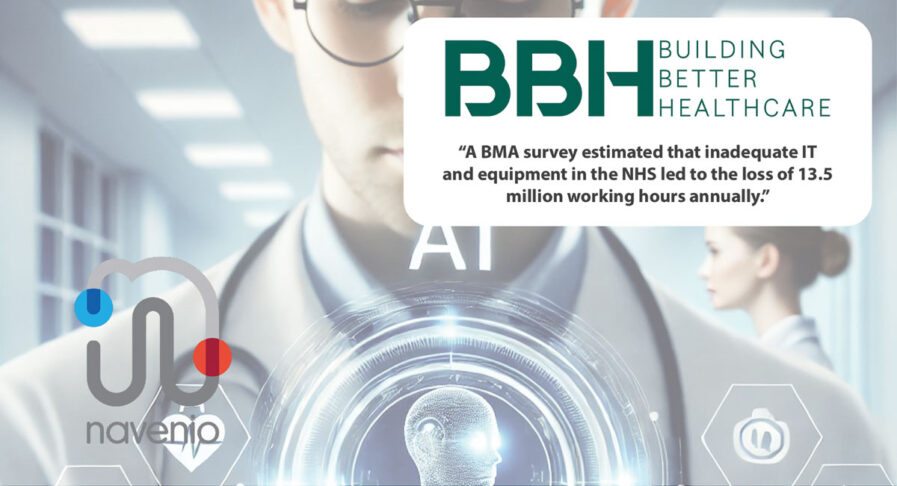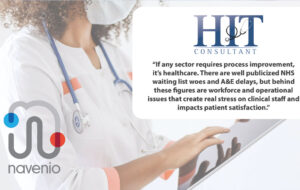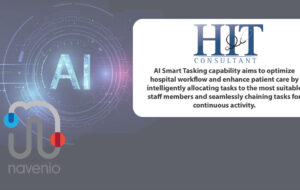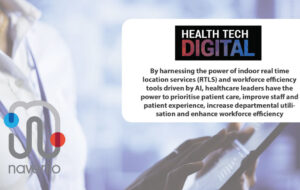Building Better Healthcare: How AI is being used to ensure operational sustainability in the NHS

As published by BuildingBetterHealthcare.com
The distressing news that more and more patients are being left in corridors in NHS hospitals “due to a lack of bed space” has only increased the call for innovative measures to address access issues.
It reflects an environment where a larger than previously reported NHS waiting list, long A & E waiting times and delays to patient discharge are all impacting quality care delivery and patient satisfaction.
Not only are resources being stretched but junior doctor strikes over pay/workloads combined with an ageing nurse workforce continue to put further pressure on operations.
This is the current environment the new Labour government is taking over. But how does the NHS improve operational processes to create sustainable change?
“The distressing news that more and more patients are being left in corridors in NHS hospitals.“
Operational sustainability centres on being able to optimise resources in real-time, helping hospitals to function within their means while also allowing for incremental capacity increases when needed.
This requires implementing new processes that facilitate seamless patient flow, optimise staff tasks and equipment allocation, and improve overall coordination and management.
However, the statistical calculations needed to deliver such a strategy are complex. With pressure continuing to build, AI offers a way to create a more sustainable model quickly.
Why are hospitals struggling to operate sustainably?
The factors described in the introduction are visible reasons for operational inefficiency. But they don’t interrogate why lists are so high or why workloads feel stretched.
There are several strategic, funding and structural reasons for these struggles. But from a purely operational standpoint, sustainability depends on the efficient flow of patients, staff and resources – and this depends on access to real-time data.
However, without the right tools, this can be a near-impossible task to gather consistently and on an ongoing basis.
NHS teams work tirelessly to meet patient demand but are trapped within the system in which they operate. With no structured way (or data) regarding task completion, recording inefficiencies and assessing people’s activities, these challenges go unnoticed.
“A BMA survey estimated that inadequate IT and equipment in the NHS led to the loss of 13.5 million working hours annually.”
For example, cleaners might be paged to specific locations and receive tasks verbally but the request itself, the time of arrival and completion of the task are not available to nursing staff to prepare patients and plan care flow.
From a technology perspective, the lack of a unified system and visibility into process flows also hinders the delivery of care. A BMA survey estimated that inadequate IT and equipment in the NHS led to the loss of 13.5 million working hours annually.
The suvery also revealed that nearly 80% of doctors saw the number of different IT systems (and their isolation) as a barrier to digital transformation. And in today’s age, operational sustainability goes hand in hand with technology.
What can trigger sustainable process change?
Creating this operational improvement is dependent on having real-time insight into the location of both staff and assets.
Using easily scalable technology like smartphones and light-tech, real-time location services (RTLS) technology, data and the ability to proactively manage care flow is just a click away.
“AI is impacting all facets of healthcare including RLTS technology.”
Such tools are also an effective way of encouraging change as they are familiar as commonly used apps.
There will always be an element of adaptation when new processes are introduced. But the reason why initiatives can fail is because they create more work and time to implement and then, after failing to deliver much improvement, processes revert back to how they were before.
Therefore, easy-to-use technology and real-time data can act as a buffer against this happening. If people can feel, or even perceive, the benefits of change, it is far more likely to stick.
However, gathering all of this data is one thing. The ability to then drive care flow by tasking both clinical and non-clinical staff depending on their location, while simultaneously sending patients to the right area depending on their needs is a whole other challenge. This is where AI can drive operational sustainability.
How AI can drive operational sustainability?
AI is impacting all facets of healthcare including RLTS technology. In particular, the combination of RTLS with an AI-based tasking functionality is allowing hospitals to automatically assign tasks for workers in real time based on priority, availability, skillset and location, creating a ‘chain of tasks’.
This means care teams can optimise task patterns to improve their workflows and reduce response times, enhancing operational efficiency, productivity and the overall patient experience. By leveraging AI and automation, this process takes place far, far faster than could ever be dreamed of without it.
“This AI-powered strategy means hospitals can optimise flow and resources.”
The improvements from using such technology can already be seen in practice. One NHS Trust achieved a 62% reduction in task completion times just three months after implementing a location-based AI tasking system.
For management, AI allows for data-driven workforce planning. On a daily and weekly basis, viewing real-time data means staff can be strategically moved to match demand patterns.
Moreover, decision-makers can then assess the historical data that has been built up with real-time circumstances to predict shifts in workloads and manage them effectively.
This AI- powered strategy means hospitals can optimise flow and resources, align workforce planning with patient demand, and foster overall operational sustainability.
The future of NHS operations
While question marks hang over AI’s use in other sectors, healthcare seems to be one of the areas where there is unanimous agreement on the benefits it can deliver.
This week it was announced that the NHS Humber Health Partnership will use AI “to reduce unnecessary admissions and lengthy stays” across the region.
“Where AI perhaps holds the most promise operationally is with RTLS, combining the real-time whereabouts of resources with AI-powered task allocation.”
This implementation is part of its flow initiative which is attempting “to streamline every stage of a patient’s progress from emergency department to discharge”. While this example sees AI completing tasks such as reading blood test results, it’s another move showing the ways AI is being used to drive efficiency in the NHS.
Where AI perhaps holds the most promise operationally is with RTLS, combining the real-time whereabouts of resources with AI-powered task allocation to build a highly sustainable and efficient operation. The more this can be built on, the better care patients will receive and the more empowered staff will feel at work.




